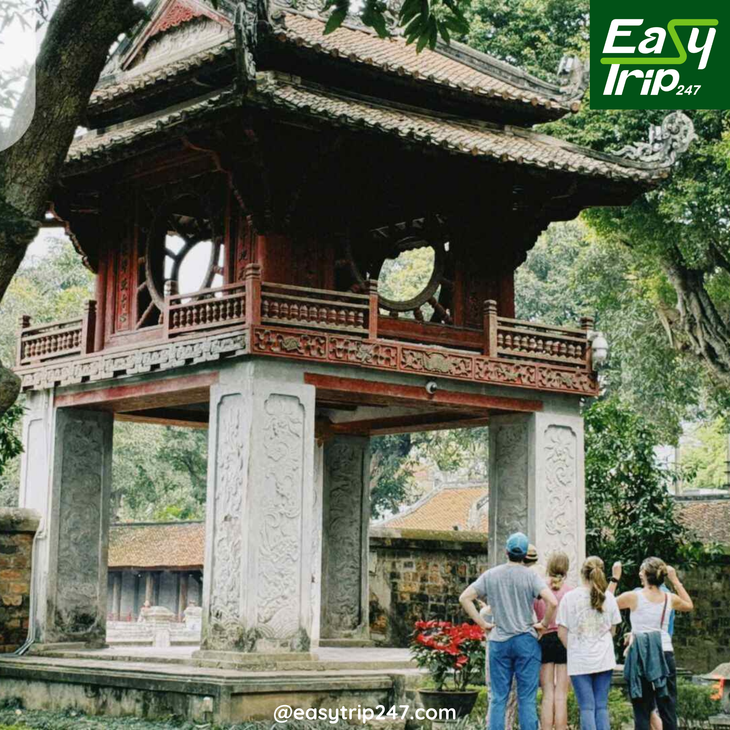Historic Houses: Walking Through Hanoi's Architecture
On
03/07/2025Reading time:
1 min
Summary:
Embarking on a walking tour in Hanoi to explore the city’s historic houses is an enriching experience that unveils the layers of culture, history, and architectural beauty that define Vietnam's capital.

Hanoi, a city where the old meets the new, boasts a stunning array of architectural styles, from traditional Vietnamese wooden houses to French colonial masterpieces. Each step on your walking tour in Hanoi reveals stories of the past, showcasing how the city has evolved over centuries while preserving its unique charm. As you meander through the streets, you’ll encounter a diverse tapestry of architecture that reflects the influences of various dynasties, colonial powers, and modern innovations, making it a captivating journey for history buffs and casual explorers alike.
Begin your walking tour in Hanoi at the Old Quarter, where the narrow streets are lined with historic houses that date back to the 19th century. This area is famous for its “tube houses,” which are narrow, elongated structures designed to maximize space in the bustling urban environment. With their distinctive facades, these houses often feature intricate wooden balconies and decorative tile work, showcasing the craftsmanship of the time. As you stroll through the Old Quarter, take a moment to admire the architectural details and imagine the lives of the families who once called these homes. The vibrant atmosphere of the Old Quarter, filled with street vendors and local shops, adds to the charm of your walking tour in Hanoi, inviting you to engage with the city’s lively culture.
Next, make your way to Hoan Kiem Lake, where you can find the Ngoc Son Temple nestled on an island. While the temple itself is a significant historical site, the surrounding area also features beautiful colonial-era buildings that reflect the French influence on Hanoi’s architecture. The contrast between the traditional Vietnamese structures and the elegant French designs creates a unique visual experience that is emblematic of the city’s architectural diversity. As you enjoy the serene views of the lake and the temple, consider how this area has served as a cultural hub for centuries, making it a perfect stop on your walking tour in Hanoi.
Continuing your walking tour in Hanoi, head towards the French Quarter, where you’ll find some of the most stunning examples of colonial architecture in the city. The wide boulevards, lined with grand buildings and leafy trees, evoke a sense of nostalgia for the colonial era. Here, you can admire the Hanoi Opera House, a magnificent structure that resembles the Palais Garnier in Paris. The opera house is not only a stunning architectural feat but also a cultural landmark that hosts various performances and events throughout the year. As you stand before this iconic building, take a moment to appreciate the artistry and design that went into its creation, making it a highlight of your walking tour in Hanoi.
As you explore the French Quarter, don’t miss the opportunity to visit the Presidential Palace. While the palace itself is not open to the public, the surrounding gardens and grounds are accessible and provide a glimpse into the grandeur of the colonial era. The palace’s design, inspired by French architecture, is a testament to the historical significance of this area. The lush gardens surrounding the palace offer a peaceful retreat from the city’s hustle and bustle, making it an ideal spot to pause and reflect on your walking tour in Hanoi. The blend of history and natural beauty here creates a serene atmosphere that enhances your exploration of the city’s architectural heritage.
Next, make your way to Bach Ma Temple, one of the oldest temples in Hanoi, which dates back to the 11th century. This historic site is a prime example of traditional Vietnamese architecture, featuring intricate carvings and beautiful altars dedicated to various deities. The temple’s location in the Old Quarter adds to its charm, as it stands in stark contrast to the surrounding modern buildings. As you explore the temple grounds, take a moment to appreciate the spiritual significance of the site and the craftsmanship that has been preserved over the centuries. Visiting Bach Ma Temple is a meaningful addition to your walking tour in Hanoi, providing insight into the city’s religious heritage and architectural diversity.
As your walking tour in Hanoi continues, head to the Museum of Vietnamese History, located in the former French Ministry of Information building. This museum not only showcases the rich history of Vietnam but also features stunning examples of colonial architecture. The building itself, with its grand columns and elegant design, serves as a reminder of the country’s complex past. Inside, you can explore various exhibits that highlight Vietnam’s cultural heritage, making it an educational stop on your walking tour in Hanoi. The museum’s blend of history and architecture creates a captivating experience that deepens your understanding of the city’s evolution.
Another must-visit site on your walking tour in Hanoi is the Hanoi Citadel, a UNESCO World Heritage site that offers a glimpse into the city’s military history. The citadel is home to various historic buildings, including the Flag Tower of Hanoi, which stands as a symbol of the nation’s resilience. As you wander through the citadel’s grounds, you’ll encounter ancient walls, traditional Vietnamese architecture, and remnants of French colonial structures. The juxtaposition of these architectural styles tells the story of Hanoi’s tumultuous history and makes the citadel a fascinating stop on your walking tour in Hanoi.
As you continue your exploration, consider visiting the Thang Long Water Puppet Theatre, where you can experience a unique aspect of Vietnamese culture. While the performances do require a ticket, the building itself is a beautiful example of traditional architecture, and the area surrounding the theatre is vibrant with activity. The art of water puppetry has deep roots in Vietnamese culture, and witnessing this performance adds a cultural layer to your walking tour in Hanoi. The theater’s design, reminiscent of ancient Vietnamese houses, enhances your appreciation for the architectural diversity found throughout the city.
To conclude your walking tour in Hanoi, make your way to Trấn Quốc Pagoda, the oldest pagoda in Hanoi, located on an island in West Lake. This stunning structure, with its striking red and gold colors, offers a serene atmosphere and breathtaking views of the lake. The pagoda’s architecture reflects traditional Vietnamese design, with intricate carvings and a peaceful garden surrounding it. As you walk around the pagoda, take in the beauty of the landscape and the tranquility of the site. This peaceful retreat serves as a fitting end to your walking tour in Hanoi, allowing you to reflect on the rich history and architectural splendor you’ve encountered throughout the day.
Design Your Tour Today And Get A Quote. Contact Us Here: +84.975.504.825
Source: Easytrip247 Team compiled.
